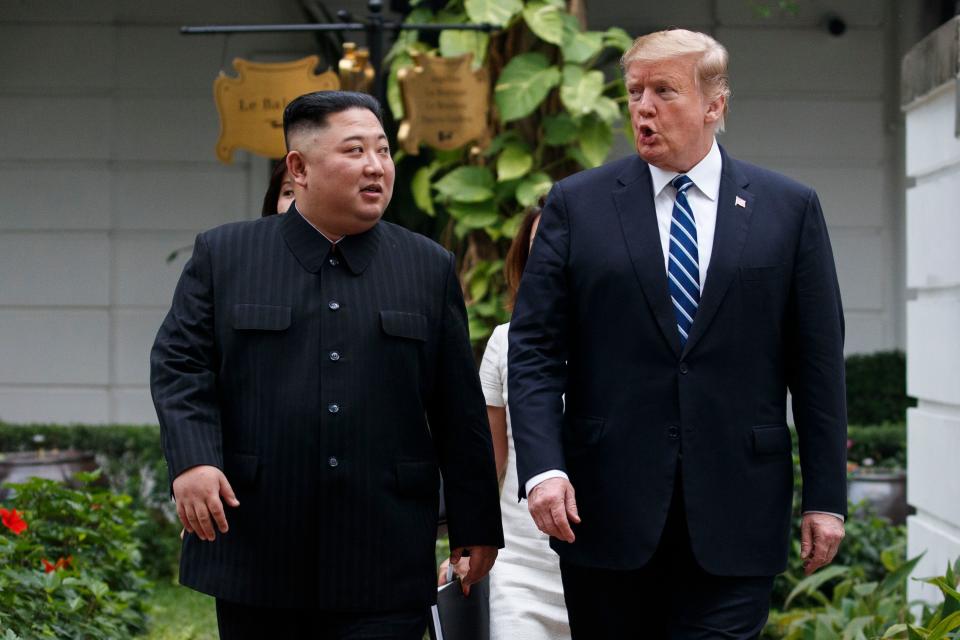After summit diplomacy collapse, what's Donald Trump's North Korea Plan B?

The abrupt end on Thursday of President Donald Trump’s much anticipated second summit with North Korean leader Kim Jong Un in Hanoi, Vietnam, seems to have thrown a wrench into the administration’s plans for peace with the Democratic People's Republic of Korea.
The precise contours of why the talks broke down aren’t fully clear as of yet. Going into the negotiations, the White House had hoped to be able to reach some sort of framework accord that would move the North Korean regime further toward denuclearization and détente. Indeed, even a more modest outcome — entailing a normalization of diplomatic ties between Washington and Pyongyang and some sort of arrangement to repatriate additional Korean War-era soldier remains — would have been a clear political victory for the Trump administration.
It’s not clear that either outcome is still possible. How fundamental the rupture between the two leaders actually is, and how unbridgeable the apparent political gaps, remains to be seen. There is still hope that through the proper mix of political carrots and strategic sticks, the administration can coax the North Korea back to the nuclear negotiating table. Even so, in the aftermath of the scrapped summit, U.S. attention by necessity needs to turn to the formulation of a “Plan B” for dealing with the strategic challenge posed by the Kim regime.

Read more commentary:
Trump and Kim Jong Un might officially end the Korean War. Here's why that could matter.
President Trump has made unthinkable progress on Korea: Rep. Babin
Donald Trump has leverage going into Vietnam summit with North Korea's Kim Jong Un
That, it should be noted, is not a new problem. For the better part of a quarter century, successive administrations in Washington have tried to figure out the best way by which to contain and deter North Korea’s menace. Some of the resulting strategies, like diplomatic engagement via the “Six Party Talks” mechanism, turned out to be diplomatic duds. Others, however, have shown considerably more promise.
Today, two avenues of pressure in particular stand out:
The first entails a further ratcheting up of sanctions pressure, and a curtailment of North Korea’s ability to engage in international commerce. The Kim regime gave every indication of pre-emptively banking on the “peace dividend” that would result from a deal with the United States, and in recent months it had stepped up its efforts to get China, South Korea and other potential international partners to make concrete investments in the country’s dilapidated infrastructure.
Indeed, such investment is integral to Kim’s grand plans for national reconstruction and economic revitalization, which are estimated to carry a whopping $63 billion price tag. Therefore, redoubled economic pressure on North Korea and its financial institutions, as well as greater oversight over its trade (both licit and illicit), is bound to have an outsize impact on North Korea’s economy and politics at the present time.
Ratchet up sanctions, neutralize threats
The second avenue of U.S. attack needs to focus on neutralizing North Korea’s increasingly sophisticated strategic arsenal. Pyongyang has indeed taken some confidence-building measures in this area since the start of talks with the Trump administration (including suspending ballistic missile and nuclear testing), and dismantling its most public nuclear project, the reactor at Yongbyon, was reportedly on the table at the aborted talks in Hanoi. But North Korea’s nuclear potential and its extensive ballistic missile capabilities remain serious (even existential) threats to regional states that America counts as its partners.
Therefore, a renewed U.S. commitment to the creation of a real, robust strategic architecture in Asia — one that includes accelerated missile-defense deployments capable of shielding America’s allies from North Korea’s missiles — is a prerequisite for the stability of our Asian alliances, and for invalidating Kim’s ability to engage in nuclear blackmail.
Whatever transpired between the two leaders in Vietnam, there’s still hope that the two countries could eventually find their way back to the negotiating table. International negotiations are complex affairs, and talks over North Korea’s nuclear program — which Pyongyang has long viewed as a staple of regime stability — are bound to be particularly thorny.
But a negotiated deal isn’t an assured outcome, or even necessarily a probable one. That’s why Washington needs to put Pyongyang on notice as to exactly what will happen if the two countries don’t eventually come to an acceptable meeting of the minds.
Ilan Berman is senior vice president at the American Foreign Policy Council in Washington, D.C. Follow him on Twitter: @ilanberman
You can read diverse opinions from our Board of Contributors and other writers on the Opinion front page, on Twitter @usatodayopinion and in our daily Opinion newsletter. To respond to a column, submit a comment to letters@usatoday.com.
This article originally appeared on USA TODAY: After summit diplomacy collapse, what's Donald Trump's North Korea Plan B?

